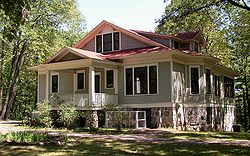Charles A. Lindbergh House and Park | |
Minnesota State Register of Historic Places
| |
 The boyhood home of aviator Charles Lindbergh stands in the park donated in memory of his father. | |
 Interactive map showing the location for Lindbergh State Park | |
| Location | Morrison County, Minnesota, United States |
|---|---|
| Nearest city | Little Falls, Minnesota |
| Coordinates | 45°57′26.78″N 94°23′23.24″W / 45.9574389°N 94.3897889°W |
| Built | 1906 |
| Architect | Carl Bolander |
| NRHP reference No. | 70000303 |
| Significant dates | |
| Added to NRHP | November 20, 1970[1] |
| Designated NHL | December 8, 1976 |
Charles A. Lindbergh State Park WPA/Rustic Style Historic Resources | |
 Water tower and picnic shelter, constructed 1938 | |
| Location | Pike Creek Township |
|---|---|
| Coordinates | 45°57′28″N 94°23′26″W / 45.95778°N 94.39056°W |
| Area | 9 acres (3.6 ha) |
| Built | 1938–39 |
| Architect | National Park Service, State of Minnesota, Works Progress Administration |
| Architectural style | NPS Rustic |
| MPS | Minnesota State Park CCC/WPA/Rustic Style MPS |
| NRHP reference No. | 89001655 |
| Added to NRHP | 1989-10-25 |
Charles A. Lindbergh State Park is a 569-acre (2.3 km2) Minnesota state park on the outskirts of Little Falls. The park was once the farm of Congressman Charles August Lindbergh and his son Charles Lindbergh, the famous aviator. Their restored 1906 house and two other farm buildings are within the park boundaries. The house, a National Historic Landmark, and an adjacent museum are operated by the Minnesota Historical Society, known as the Charles Lindbergh House and Museum. Three buildings and three structures built by the Works Progress Administration in the 1930s were named to the National Register of Historic Places. These buildings include a picnic shelter and a water tower, built in the Rustic Style from local stone and logs, and have remained relatively unchanged since construction. Although the property includes shoreline on the Mississippi River, the Lindbergh family requested that the park not include intensive use areas for swimming or camping, so development was kept to a minimum.

